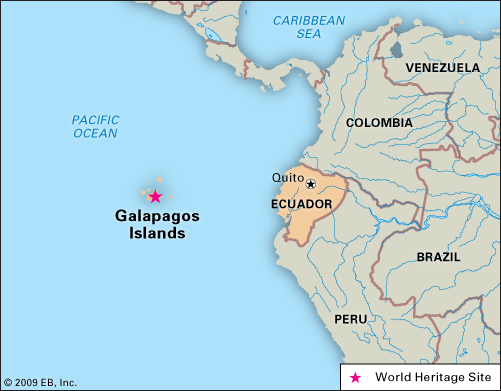Description


Disclaimer: Copyright infringement not intended.
Context
Galapagos Islands to Double Entry Fees.
Details
Galápagos Islands:
- The Galápagos Islands are a chain of islands, or archipelago, in the eastern Pacific Ocean.
- They are part of the country of Ecuador, in South America. The Galápagos lie about 966 kilometers (600 miles) off of the Ecuadorian coast.
- There are thirteen major islands and a handful of smaller islands that make up the Galápagos archipelago.
- The largest of the islands is called Isabela. It is approximately 129 kilometers (80 miles) long.
- Formation: Repeated volcanic eruptions helped to form the rugged mountain landscape of the Galápagos Islands.
- It is a UNESCO World Heritage
Biodiversity of the Island:
- The Galápagos are best known for their diverse array of plant and animal species. Many species are endemic, include the giant Galápagos tortoise (Chelonoidis nigra), the marine iguana (Amblyrhynchus cristatus), the flightless cormorant (Phalacrocoraz harrisi), and the Galápagos penguin.
- The Galápagos penguin (Spheniscus mendiculus) is the only penguin species to live in the Northern Hemisphere.

Climate:
- The Galápagos Islands are located near the equator, yet they receive cool ocean currents. This makes for a strange mix of tropical and temperate climates.
- For most of their history, the islands have been extremely isolated. This combination of factors created a laboratory for the evolution of an unusual mix of plant and animal species.
Balancing Tourism and Conservation:
- The Galapagos Islands are home to a diverse array of endemic species, including giant tortoises and marine iguanas.
- These irreplaceable creatures are particularly vulnerable to human interaction and habitat disruption.
- Increased tourism can lead to the introduction of invasive species, disruption of wildlife breeding grounds, and strain on the islands' fragile ecosystems.
- The islands are home to 30000 people but typically see 170000 travellers annually.
- Ecological risks due to rising visitor numbers and increased land-based tourism strains waste management, worsens water and food scarcity, and heightens the risk of invasive species introduction.
|
PRACTICE QUESTION
Galápagos Islands are part of which of the following country?
- Colombia
- Peru
- Chile
- Ecuador
Answer D
|















